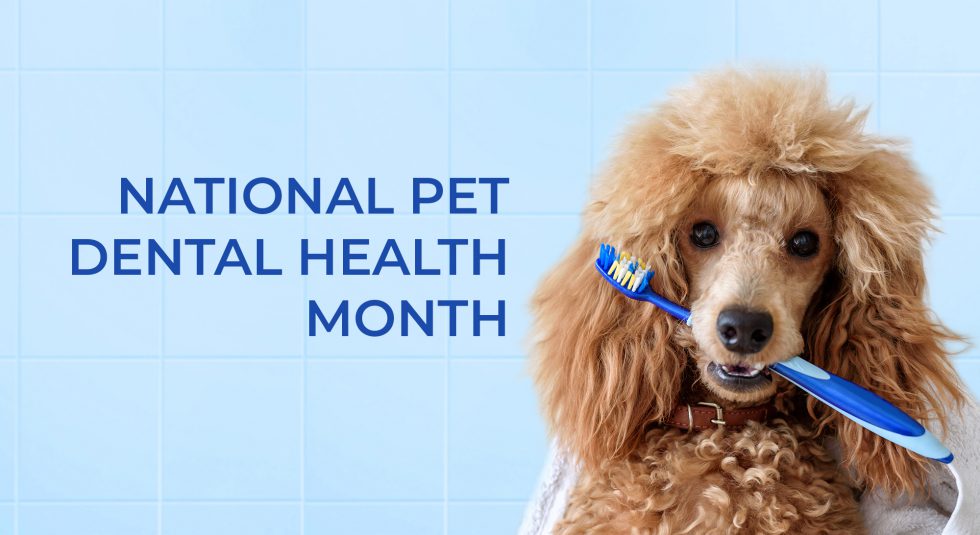Wait, there’s a National Pet Dental Health Month?
Let’s face it, there’s a month for everything. But this one is near and dear to my heart. You see, as a general practice veterinarian, the vast majority of my patients have some level of periodontal disease. That is, 80% of dogs and 70% of cats by age three. That’s a lot of teeth (and gums) that need attention. And here’s the thing: while we’ve all seen the pictures of the world’s ugliest dog who needs most of his teeth removed because his mouth is obviously a lost cause, the early stages of periodontal disease are reversible with proper treatment. Saving the savable teeth is what Pet Dental Health Month is all about.
What is dental disease?
Did you know that “dental disease” isn’t just about the teeth? Far from it! In fact, the medical term for it, periodontal disease, is a much better descriptor, because most of the problem is actually with the soft tissue and bone that surround (“peri-”) the teeth (“dontal”). It all starts with the bacteria in the mouth forming a soft substance called plaque. This sticks to the teeth and will eventually harden into calculus, or tartar. The nasty bacteria thriving within the plaque and tartar causes an inflammatory response in an attempt to kill the bacteria off, but that same process damages the oral tissues as well. This inflammation and damage leads to bad breath (halitosis), infection, chronic pain, and bone loss around the teeth. Left unchecked, the damage will progress until the teeth eventually loosen and fall out.
Even scarier than the effect of periodontal disease on the mouth is the fact that the inflammation and infection impacts the rest of the body as well. Kidney, heart, and liver disease have all been associated with periodontal disease. Because the gum tissues are inflamed, they are more likely to allow bacteria from the mouth into the bloodstream. These bacteria then travel to the rest of the body, setting up shop in the organs and causing chronic inflammation and infections there. Yikes, right? Scarier yet, these changes will most likely happen without you noticing. However, your veterinarian may be able to pick up early signs of these kinds of problems with diagnostic tests on the blood and urine.
So what do we do about all this horrifying information?
Your first stop should be a thorough wellness check-up with your veterinarian, including an oral exam. This will allow your vet to assess the mouth as well as your pet’s overall health and make the best recommendation for moving forward. If you are lucky and your pet doesn’t have evidence of periodontal disease yet, starting preventative care at home will help keep it that way. You guessed it – I mean brushing their teeth. You may laugh, but done right, brushing is not only easy and fun for both you and your pet (yes, cats included), but it is the single best thing you can do to keep the mouth healthy and comfortable – and it’s cheap to boot. Brushing daily is best, but the minimum if you really want to make a difference is three times a week.
If you are not quite so lucky, and your pet already has periodontal disease, you will need to discuss the next steps with them. Thankfully, the early stages of periodontal disease are reversible with proper treatment. For very early disease, this may just mean starting to brush daily. If it’s a bit more advanced and there is already calculus, your vet may recommend a cleaning and evaluation under anesthesia, followed by regular brushing at home. If it’s very advanced, be prepared for extractions or more advanced periodontal treatments. If your vet does find periodontal disease, be sure to ask them if they think the mouth is likely to be painful, and if the answer is yes, wait on starting your brushing routine until those areas of severe disease have been treated. The last thing you want is for your pet to associate brushing with pain, because that will make it much harder to keep up with the routine later on.
A Side note – Buyer Beware
Many folks assume that chewing on bones will solve the problem of periodontal disease. But bones also carry significant risk of breaking teeth, which will then either need extraction or a root canal. Both of these will be painful and cost a significant amount of money. Bones can also be swallowed, get stuck on the jaw, and if they are raw, carry nasty bacteria like salmonella and E. coli, which could make your pet (and you) very sick. Be very careful, or just stick with brushing. It’s safer, and more reliably cleans underneath the gum line, where it counts.
Another enticing possibility is “anesthetic-free dentals.” Please discuss this with your veterinarian, as they unfortunately carry additional risks and are cosmetic only, rather than treating and preventing periodontal disease. See this great website for more information.
How to get started
All you need is a bag of treats and a soft-bristled brush. A pet brush is fine, but I like human brushes designed for children or infants. Toothpaste (pet-specific only) is optional and can sometimes make brushing more difficult because your pet wants to lick it off the brush.
Because a lot of pets may not like having their mouths handled, or are just confused when you dive right in and try to brush, I’ve put together a complete online course called Healthy Smiles to take you through the step-by-step training your pet needs to not only allow you to brush but to love it. Even pets who are worried about having their mouths handled can learn to enjoy it if you follow the training plan carefully. The protocols in this course include both classical (CER) and operant conditioning and are based on Academy teachings: we ALWAYS use a step-by-step plan; clearly define our criteria; increase the difficulty incrementally and according to defined push-drop-stick protocols; and of course we always have room to add additional steps (splits) as necessary for an individual pet. The course also discusses all the ins and outs of a complete home dental care program, other products or services you may see, and a one-on-one interview with Dr. Milinda Lommer, a board-certified veterinary dental specialist, who shares her best recommendations for home care with us.
With all of us home more during the pandemic, there’s never been a better time to get started brushing. Most dogs will be cheerfully participating in their dental care after just a week or two of daily 5-10 minute sessions. Some dogs will move faster, and some will require a slower pace, of course. And if you are working with a cat, be prepared to take it slow! I can’t tell you how thrilled I am when a client tells me they brush their pet’s teeth – so get going, and make your vet proud!
*A version of this blog was previously published in the Tahoe Daily Tribune.
Rachel Szumel is a graduate of the University of California, Davis School of Veterinary Medicine, and practices in beautiful South Lake Tahoe, California. She earned her CTC from The Academy in 2015, and is extra-super-thrilled when good training can help her provide better medical care to her patients.












